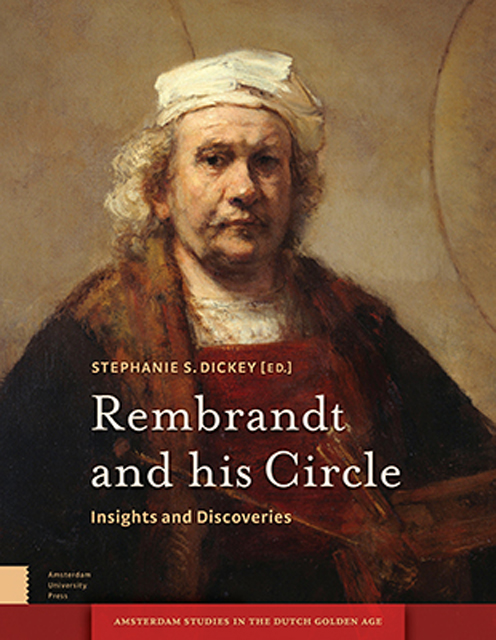Book contents
- Frontmatter
- Dedication
- Contents
- Acknowledgements
- Introduction
- 1 Rembrandt and Frans Hals Painting in the Workshop of Hendrick Uylenburgh
- 2 Rembrandt and the Germanic Style
- 3 Rembrandt and the Humanist Ideal of the Universal Painter
- 4 Curiosity and Desire: Rembrandt’s Collection as Historiographic Barometer
- 5 Painted Landscapes by Lievens and Rembrandt : The View from Seventeenth-Century Amsterdam Collections
- 6 Jan Lievens in Antwerp: Three Rediscovered Works
- 7 Gerrit Dou as a Pupil of Rembrandt
- 8 A New Painting by Jan van Noordt in Budapest
- 9 Rembrandt’s First Nude? The Recent Analysis of Susanna and the Elders from Rembrandt’s Workshop
- 10 Rembrandt’s Head of Christ: Some Technical Observations concerning Matters of Style
- 11 A Rediscovered Head of John the Baptist on a Platter from Rembrandt’s Studio
- 12 Rembrandt’s One Guilder Print: Value and Invention in ‘the most beautiful [print] that ever came from the burin of this Master’
- 13 Rembrandt, Ferdinand Bol, and Tobit: The Emergence of a Pathosträger
- 14 Biblical Iconography in the Graphic Work of Rembrandt’s Circle
- 15 Jan van Vliet and Rembrandt van Rijn: Their Collaboration Reassessed
- 16 Printmaking among Artists of the Rembrandt School
- 17 Chain Line Pattern Matching and Rembrandt’s Prints
- List of Illustrations
- Bibliography
- Index Nominum
14 - Biblical Iconography in the Graphic Work of Rembrandt’s Circle
Published online by Cambridge University Press: 21 January 2023
- Frontmatter
- Dedication
- Contents
- Acknowledgements
- Introduction
- 1 Rembrandt and Frans Hals Painting in the Workshop of Hendrick Uylenburgh
- 2 Rembrandt and the Germanic Style
- 3 Rembrandt and the Humanist Ideal of the Universal Painter
- 4 Curiosity and Desire: Rembrandt’s Collection as Historiographic Barometer
- 5 Painted Landscapes by Lievens and Rembrandt : The View from Seventeenth-Century Amsterdam Collections
- 6 Jan Lievens in Antwerp: Three Rediscovered Works
- 7 Gerrit Dou as a Pupil of Rembrandt
- 8 A New Painting by Jan van Noordt in Budapest
- 9 Rembrandt’s First Nude? The Recent Analysis of Susanna and the Elders from Rembrandt’s Workshop
- 10 Rembrandt’s Head of Christ: Some Technical Observations concerning Matters of Style
- 11 A Rediscovered Head of John the Baptist on a Platter from Rembrandt’s Studio
- 12 Rembrandt’s One Guilder Print: Value and Invention in ‘the most beautiful [print] that ever came from the burin of this Master’
- 13 Rembrandt, Ferdinand Bol, and Tobit: The Emergence of a Pathosträger
- 14 Biblical Iconography in the Graphic Work of Rembrandt’s Circle
- 15 Jan van Vliet and Rembrandt van Rijn: Their Collaboration Reassessed
- 16 Printmaking among Artists of the Rembrandt School
- 17 Chain Line Pattern Matching and Rembrandt’s Prints
- List of Illustrations
- Bibliography
- Index Nominum
Summary
Abstract
Although Rembrandt's printmaking was highly appreciated in his own time, he did not make it a focus of his teaching in the studio. His biblical prints had only a limited impact on his students and on artists inspired by his paintings at a distance. This article highlights the difference between the first decade of Rembrandt's work, when there is an intensive exchange with Jan Lievens and Jan van Vliet, and the period after 1635, when he trained a large number of students but kept printmaking largely to himself. In both periods, although artists in Rembrandt's milieu produced prints, there are revealing differences both in frequency and in their approach to biblical subjects. A case in point is a biblical print etched by Samuel van Hoogstraten in 1648. The iconographic associations brought to light here contribute to the growing interest in the graphic output of the circle of Rembrandt. However modest it may have been, it deserves further investigation.
Keywords: Rembrandt van Rijn, Samuel van Hoogstraten, Jan van Vliet, Jan Lievens, etching, printmaking, Bible
Rembrandt produced prints for nearly his entire working life, from the beginning of his artistic career in Leiden and right through his glory years in Amsterdam. Only towards the end did he gradually give up etching. Rembrandt developed himself from an inexperienced amateur to an unrivaled explorer of the limits of his medium. His graphic oeuvre is especially varied. Just about all traditional subject areas are represented: saints, landscapes, genre scenes, portraits, nudes, mythological scenes, and still lifes. However, biblical histories appear most often. Of Rembrandt's more than 300 etchings nearly a quarter feature scriptural themes: eighteen from the Old Testament and around fifty-five from the New. Prints with biblical subject matter not only dominate in terms of numbers, they also played a determining role in Rembrandt's artistic development. The most ambitious works in this area, New Testament etchings in large format, form the turning points in his oeuvre.
Although Rembrandt's prints were highly prized by amateurs and collectors and found an international market, it is well known that he did not cultivate a following with them.
- Type
- Chapter
- Information
- Rembrandt and his CircleInsights and Discoveries, pp. 268 - 284Publisher: Amsterdam University PressPrint publication year: 2017



